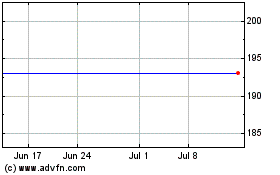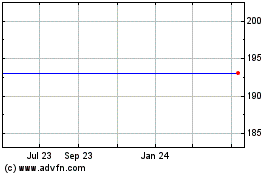By Richard Rubin
WASHINGTON-- Pfizer Inc.'s decision to escape the U.S. tax
system by putting its legal headquarters in Ireland puts even more
pressure on lawmakers to revamp tax rules and prevent the corporate
tax base from eroding. But the largest corporate inversion in
history is unlikely to dislodge the obstacles that have prevented
action.
The political and technical hurdles to overhauling the tax
code--even a limited set of changes to the taxation of U.S.
companies' foreign income--have stymied lawmakers for years. And
the fragile consensus that emerged between President Barack Obama
and congressional Republicans is now under attack from both
sides.
Pfizer and Allergan agreed on a merger deal worth more than $150
billion that would create the world's biggest drug maker and move
one of the top names in corporate America to a foreign country.
"This only further underscores the arcane, anticompetitive
nature of the U.S. tax code," Senate Finance Committee Chairman
Orrin Hatch (R., Utah) said after Pfizer's announcement. "Short of
a tax overhaul that will make it easier for American companies to
invest and create more jobs at home, Washington ought to work
together to explore viable policy-driven, apolitical solutions that
will effectively combat inversions."
That is tough to do. Sens. Charles Schumer (D., N.Y.) and Rob
Portman (R, Ohio), along with House Speaker Paul Ryan (R., Wis.)
and Ways and Means Chairman Kevin Brady (R., Texas), have been
trying to keep hope alive for a limited international tax deal in
2016, even after they couldn't attach one to a long-term highway
bill.
The closer the presidential election gets, the harder that
becomes. Republican presidential candidates have cited inversions
in proposing their own plans to revamp the tax code. Vermont Sen.
Bernie Sanders, a Democratic presidential candidate, called the
Pfizer deal a "disaster" Monday and said the administration should
block it.
Democratic front-runner Hillary Clinton said U.S. taxpayers
would be left "holding the bag" because of the Pfizer deal. Mrs.
Clinton said Monday she would be proposing specific business-tax
proposals in the coming weeks. "I urge Congress to act immediately
to make sure the biggest corporations pay their fair share, and
regulators also should look hard at stronger actions they can take
to stop companies from shifting earnings overseas," she said.
Under current law, U.S. companies pay the full 35% corporate tax
rate--the developed world's highest--on all income they earn around
the world. They get tax credits for payments to foreign governments
and can defer the residual U.S. tax until they bring the money
home.
That system, combined with rules that let foreign-based
companies shift profits out of the U.S., give companies incentives
to shift profits overseas or simply move their tax address to a
low-tax country. As a result, few large multinationals pay 35%,
especially those in the technology and pharmaceutical industries,
where it is easier to locate profits in low-tax jurisdictions.
According to securities filings, Pfizer hasn't reported a pretax
profit in the U.S. since 2007. Now, Pfizer is joining Medtronic PLC
and Mylan NV outside the U.S. tax system. Pfizer cited taxes as one
of the main reasons for its inversion, accomplished through a
merger with Allergan PLC.
"There are benefits from tax," Pfizer Chief Executive Ian Read
said Monday on CNBC. "If the benefits from tax weren't there, I
would still try to do the deal, but I suspect the price would be
different."
Each of the big inversion deals has prompted calls from
Democrats and Republicans to make major structural changes. But the
parties disagree on exactly what a new system should look like, and
they have had trouble separating international taxes from the much
tougher questions about the rest of the business tax system and
individual taxation. Democrats, too, are much more eager to impose
immediate curbs on inversions while they work on broader changes,
and members of both parties say the two rounds of rules announced
by the Treasury Department aren't enough. Treasury released its
second set of inversion curbs last week.
"Tax-motivated corporate inversions have cost the U.S. tens of
billions of dollars, and place an increasing burden on American
taxpayers," said Rep. Sander Levin (D., Mich.), the top Democrat on
the Ways and Means Committee. "It is clear that Republicans in
Congress need to join Democrats in stepping up to the plate to
address this issue."
Mr. Obama ran for office promising to end tax breaks that ship
jobs overseas. Early in his presidency, he proposed tougher limits
on companies' ability to defer their U.S. taxes on foreign income.
Over time, he scaled back those proposals and began moving toward
the Republican position.
Mr. Obama, big businesses and congressional Republicans
eventually reached positions that roughly overlapped: A lower
corporate tax rate, fewer breaks, lighter taxes on foreign income
and a one-time tax on the more than $2 trillion in stockpiled
foreign earnings. They split when it came to which breaks should go
away and how the proceeds from that one-time tax should be spent.
And they struggled with the politics of advancing a corporate tax
bill without cutting rates for small businesses or simplifying the
system for individuals.
Now even that consensus is starting to fray. Mr. Brady, the new
Ways and Means chairman, says the U.S. should cut its corporate tax
rate to 20% or lower. He argues the U.S. has gotten left behind as
other countries cut their rates and that the 28% rate proposed by
Mr. Obama or the 25% rate that was the Republican position is no
longer low enough.
Meanwhile, some Democrats, notably Sen. Elizabeth Warren of
Massachusetts, are criticizing Mr. Obama's proposals from the
opposite direction. In a speech last week, Ms. Warren said
corporations pay too little in taxes and called parts of Mr.
Obama's plan a "giant wet kiss" to big companies.
Write to Richard Rubin at richard.rubin@wsj.com
(END) Dow Jones Newswires
November 23, 2015 14:29 ET (19:29 GMT)
Copyright (c) 2015 Dow Jones & Company, Inc.
Allergan (NYSE:AGN)
Historical Stock Chart
From Mar 2024 to Apr 2024

Allergan (NYSE:AGN)
Historical Stock Chart
From Apr 2023 to Apr 2024
